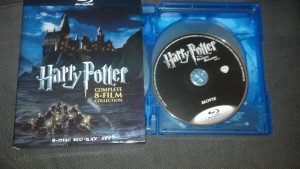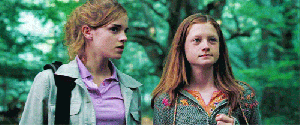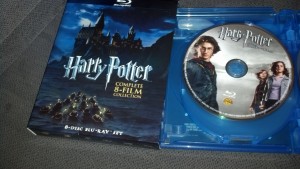The Task: Watch and write about every movie on my shelf, in order (Blu-rays are sorted after DVDs), by June 10, 2015. Remaining movies: 56 Days to go: 40
Movie #384: Harry Potter and the Deathly Hallows, Part 2
Since that midnight showing of Chamber of Secrets back in 2002, I don’t think there was a single Harry Potter film I didn’t attend a midnight screening for. I was certainly not going to miss the first showing of the final installment. Being the end of the series, though, the midnight screening was handled a little differently. Instead of a single night of screenings of a single film, my local AMC theater offered an entire week of screenings — Monday thru Thursday — of the entire series, much like I’ve done for these posts. My husband, mother-in-law and stepdaughter went every night and watched two films, all leading up to the final night of Deathly Hallows part 1, followed by the midnight release of Harry Potter and the Deathly Hallows Part 2. That final morning, though — Thursday, July 14, 2011 — I had a growing suspicion and I took a test to confirm it. I was pregnant. It was scary and unexpected, but also thrilling and incredible. And I will always associate my first knowledge of my darling little princess with the final Harry Potter film. It’s fitting, really, because life, as we know, goes on. In our world as well as this fictional one.
From the very start of the series, death has always been an accepted and even integral part of life in the magical world. So it follows that death is an integral part of this last film as well. Indeed, it is his unnatural obsession with thwarting death, with living forever, that corrupts Voldemort (Ralph Fiennes) so completely. No one is meant to live forever, and the twisted desire to will result in the ruination of your soul. It is for this reason that Harry (Daniel Radcliffe) goes to die in the forest. It is the next logical step in the mystery, and the next step in destroying Voldemort. And as Neville (Matthew Lewis) says when they all think Harry has died, he still lives within them, just as all their fallen comrades do. “People die every day.” But not Harry. Harry is the boy who lived.
The maturation of Neville Longbottom over the course of the eight films is easily one of the most moving among all the characters. Not only has he changed physically (and oh, has he changed — Neville’s transformation from a schlubby kid to a tall, impressive young man is perhaps the best example to kids that they won’t always be the awkward dope they are at 11), but he’s grown in confidence and abilities too. He’s a leader now, and an inspiration to others. He’s also a courageous fighter, and it is he, not Harry, not Ron (Rupert Grint) and not Hermione (Emma Watson) who kills Voldemort’s snake Nagini.
Other characters get some triumphant moments in Part 2 as well. Professor McGonagall (Maggie Smith) stands up to Snape (Alan Rickman) and Slytherins looking to turn over Harry alike, as well as to use the spell she’s always wanted to use, in the protection of Hogwarts. Likewise, it is Luna (Evanna Lynch) and her rare and logical reasoning that directs Harry to the ghost of Helena Ravenclaw (Kelly Macdonald) to find the lost Ravenclaw diadem, long since turned into another of Voldemort’s horcruxes. And prototypical nurturer Molly Weasley (Julie Walters) has always been a formidable mother to her children, but mostly just a loving and gracious host the rest of the time. Not so when Ginny (Bonnie Wright) is threatened by mad killer Bellatrix Lestrange (Helena Bonham Carter). “Not my daughter, you bitch,” she shouts, and she unleashes some seriously badass magic, shriveling Bellatrix into nothing and then exploding her apart. Take THAT, you evil witch!
Helena Bonham Carter, of course, is a phenomenal actress, and no scene is better than her acting as Hermione disguised as Bellatrix via Polyjuice Potion. The uncertainty and stilted nature of her carriage and speech is masterful and so unlike the unflinching cruelty Carter infuses Bellatrix with normally. It may have been a longshot, but I really would’ve liked to see a Best Supporting Actress Oscar nomination for her in this film. She earned it, completely.
The movie is different from Rowling’s text in several places, as it needs to be in order to transform the story to a visual medium, but the spirit of the narrative remains largely intact to a really impressive degree. There are thrilling action sequences, weighty emotional scenes, and an almost zen acceptance of the inevitability of what’s to come. Be it the goblin Griphook (Warwick Davis) leading Harry, Ron and Hermione into Bellatrix’s vault at Gringott’s Bank, and their subsequently wild escape on the back of a dragon, the terrifying release of the Fiendfyre in the Room of Requirement, Snape’s loving and heartbreaking memories of Harry’s mother Lily (Geraldine Somerville) (and Snape’s role in Dumbledore’s plan), Harry’s talk with Dumbledore (Michael Gambon) in the heavenly King’s Cross Station, or Harry’s final battle with Voldemort, the film moves seamlessly between moods and tones and creates a world as fully realized on the screen as it was in our minds when reading the books. “Of course it’s happening inside your head, Harry, but why should that mean that it’s not real?”
Harry Potter and the Deathly Hallows Part 2 does not hold back at all, and several lives are lost in the course of the film. Characters on both sides are killed, and many of our favorites are still being mourned by fans. (I will never ever get over my beloved Fred (James Phelps) having to perish.) But death is a part of life, and no one can live forever except in our hearts. Which they do, as evidenced by the children we have to carry on our names and legacies, and the children Harry and Ginny and Ron and Hermione have as they start a brand new cycle of life and growth by sending their own children off to Hogwarts. A new generation to grow and change, to face their own trials, their own triumphs, and their own lives.
Life, as we know, goes on.







